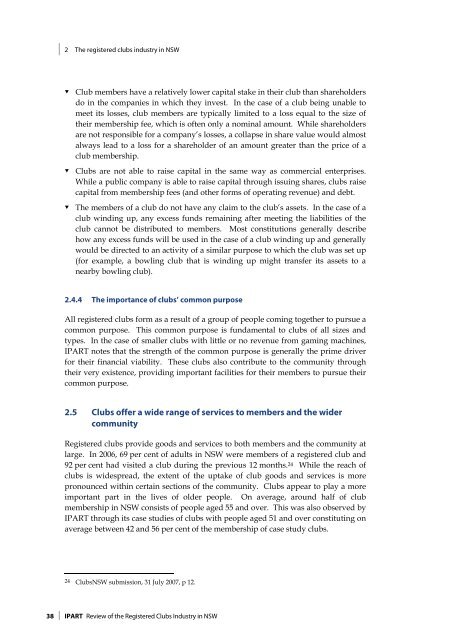Review of the Registered Clubs Industry in NSW - Clubs NSW
Review of the Registered Clubs Industry in NSW - Clubs NSW
Review of the Registered Clubs Industry in NSW - Clubs NSW
Create successful ePaper yourself
Turn your PDF publications into a flip-book with our unique Google optimized e-Paper software.
2 The registered clubs <strong>in</strong>dustry <strong>in</strong> <strong>NSW</strong><br />
<br />
<br />
<br />
Club members have a relatively lower capital stake <strong>in</strong> <strong>the</strong>ir club than shareholders<br />
do <strong>in</strong> <strong>the</strong> companies <strong>in</strong> which <strong>the</strong>y <strong>in</strong>vest. In <strong>the</strong> case <strong>of</strong> a club be<strong>in</strong>g unable to<br />
meet its losses, club members are typically limited to a loss equal to <strong>the</strong> size <strong>of</strong><br />
<strong>the</strong>ir membership fee, which is <strong>of</strong>ten only a nom<strong>in</strong>al amount. While shareholders<br />
are not responsible for a company’s losses, a collapse <strong>in</strong> share value would almost<br />
always lead to a loss for a shareholder <strong>of</strong> an amount greater than <strong>the</strong> price <strong>of</strong> a<br />
club membership.<br />
<strong>Clubs</strong> are not able to raise capital <strong>in</strong> <strong>the</strong> same way as commercial enterprises.<br />
While a public company is able to raise capital through issu<strong>in</strong>g shares, clubs raise<br />
capital from membership fees (and o<strong>the</strong>r forms <strong>of</strong> operat<strong>in</strong>g revenue) and debt.<br />
The members <strong>of</strong> a club do not have any claim to <strong>the</strong> club’s assets. In <strong>the</strong> case <strong>of</strong> a<br />
club w<strong>in</strong>d<strong>in</strong>g up, any excess funds rema<strong>in</strong><strong>in</strong>g after meet<strong>in</strong>g <strong>the</strong> liabilities <strong>of</strong> <strong>the</strong><br />
club cannot be distributed to members. Most constitutions generally describe<br />
how any excess funds will be used <strong>in</strong> <strong>the</strong> case <strong>of</strong> a club w<strong>in</strong>d<strong>in</strong>g up and generally<br />
would be directed to an activity <strong>of</strong> a similar purpose to which <strong>the</strong> club was set up<br />
(for example, a bowl<strong>in</strong>g club that is w<strong>in</strong>d<strong>in</strong>g up might transfer its assets to a<br />
nearby bowl<strong>in</strong>g club).<br />
2.4.4 The importance <strong>of</strong> clubs’ common purpose<br />
All registered clubs form as a result <strong>of</strong> a group <strong>of</strong> people com<strong>in</strong>g toge<strong>the</strong>r to pursue a<br />
common purpose. This common purpose is fundamental to clubs <strong>of</strong> all sizes and<br />
types. In <strong>the</strong> case <strong>of</strong> smaller clubs with little or no revenue from gam<strong>in</strong>g mach<strong>in</strong>es,<br />
IPART notes that <strong>the</strong> strength <strong>of</strong> <strong>the</strong> common purpose is generally <strong>the</strong> prime driver<br />
for <strong>the</strong>ir f<strong>in</strong>ancial viability. These clubs also contribute to <strong>the</strong> community through<br />
<strong>the</strong>ir very existence, provid<strong>in</strong>g important facilities for <strong>the</strong>ir members to pursue <strong>the</strong>ir<br />
common purpose.<br />
2.5 <strong>Clubs</strong> <strong>of</strong>fer a wide range <strong>of</strong> services to members and <strong>the</strong> wider<br />
community<br />
<strong>Registered</strong> clubs provide goods and services to both members and <strong>the</strong> community at<br />
large. In 2006, 69 per cent <strong>of</strong> adults <strong>in</strong> <strong>NSW</strong> were members <strong>of</strong> a registered club and<br />
92 per cent had visited a club dur<strong>in</strong>g <strong>the</strong> previous 12 months. 24 While <strong>the</strong> reach <strong>of</strong><br />
clubs is widespread, <strong>the</strong> extent <strong>of</strong> <strong>the</strong> uptake <strong>of</strong> club goods and services is more<br />
pronounced with<strong>in</strong> certa<strong>in</strong> sections <strong>of</strong> <strong>the</strong> community. <strong>Clubs</strong> appear to play a more<br />
important part <strong>in</strong> <strong>the</strong> lives <strong>of</strong> older people. On average, around half <strong>of</strong> club<br />
membership <strong>in</strong> <strong>NSW</strong> consists <strong>of</strong> people aged 55 and over. This was also observed by<br />
IPART through its case studies <strong>of</strong> clubs with people aged 51 and over constitut<strong>in</strong>g on<br />
average between 42 and 56 per cent <strong>of</strong> <strong>the</strong> membership <strong>of</strong> case study clubs.<br />
24 <strong>Clubs</strong><strong>NSW</strong> submission, 31 July 2007, p 12.<br />
38 IPART <strong>Review</strong> <strong>of</strong> <strong>the</strong> <strong>Registered</strong> <strong>Clubs</strong> <strong>Industry</strong> <strong>in</strong> <strong>NSW</strong>
















